Wildlife Trust for Bedfordshire, Cambridgeshire and Northamptonshire
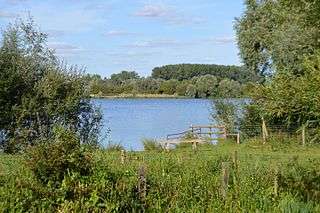
The Wildlife Trust for Bedfordshire, Cambridgeshire and Northamptonshire (WTBCN) is a registered charity which manages 126 nature reserves covering 3,945 hectares (15.23 square miles). It has over 35,000 members, and 95% of people in Bedfordshire, Cambridgeshire and Northamptonshire live within five miles of a reserve. In the year to 31 March 2016 it employed 105 people and had an income of £5.1 million.[1][2] It aims to conserve wildlife, inspire people to take action for wildlife, offer advice and share knowledge.[3] The WTBCN is one of 36 wildlife trusts covering England, and 47 covering the whole of the United Kingdom.[4]
In 1912 Charles Rothschild formed the Society for the Promotion of Nature Reserves to protect sites considered "worthy of preservation". The society worked to secure statutory protection, and this began with the National Parks and Access to the Countryside Act 1949. In 1959 the society took on a coordinating role for local wildlife trusts, which covered the whole of Britain and Northern Ireland by 1978. The society changed its name to the Royal Society of Wildlife Trusts in 2004, and it operates as The Wildlife Trusts.[4]
In 1956 the Cambridgeshire and Isle of Ely Naturalists’ Trust was founded, and it was followed by the Bedfordshire and Huntingdonshire Wildlife Trust in 1961, the Northamptonshire Wildlife Trust in 1963, and the Peterborough Wildlife Group in 1987. The Bedfordshire and Cambridgeshire trusts merged in 1990, and a further merger produced the Wildlife Trust for Bedfordshire, Cambridgeshire and Northamptonshire and Peterborough in 1994. Peterborough was dropped from the name (but still covered by the trust) in 2011.[5]
Fifty-two reserves are Sites of Special Scientific Interest (SSSI), six are Ramsar wetland sites of international importance, six are Special Protection Areas under the European Union Directive on the Conservation of Wild Birds, two are National Nature Reserves, four are Nature Conservation Review sites, one is a Special Area of Conservation, two are in the Chilterns Area of Outstanding Natural Beauty, one is a Geological Conservation Review site and eighteen are Local Nature Reserves. The largest site is Ouse Washes at 186 hectares (460 acres), which is internationally significant for wintering and breeding wildfowl and waders.[6] The smallest, at 0.7 hectares (1.7 acres), are Chettisham Meadow and Stoke Wood End Quarter, both of which are SSSIs.[7][8]
Nature reserves
Key
Designations |
Public access
|
Bedfordshire reserves
| Site | Photograph | Area[lower-alpha 1] | Location[lower-alpha 1] | Public access | Desig- nations |
Description |
|---|---|---|---|---|---|---|
| Arlesey Old Moat and Glebe Meadows[9] | 4.3 hectares (11 acres) | Arlesey 52°01′16″N 0°16′08″W / 52.021°N 0.269°W TL189373 |
YES | Frogs, toads and newts spawn in the moat, and dragonflies lay their eggs in it. The meadows have a range of wild flowers, and woodland, which is managed by coppicing, provides a habitat for nesting warblers.[9] | ||
| Barton Gravel Pit[10] | 1.1 hectares (2.7 acres) | Barton-le-Clay 51°57′25″N 0°24′11″W / 51.957°N 0.403°W TL098299 |
YES | This former gravel pit has been partially filled in to become flower-rich chalk grassland. Plants include knotted hedge-parsley, common poppy and great pignut. Mature beech trees provide a habitat for the white helleborine orchid.[10] | ||
| Begwary Brook[11] | 0.8 hectares (2.0 acres) | Begwary 52°11′38″N 0°17′24″W / 52.194°N 0.290°W TL169564 |
YES | Gravel extraction has created a small lake and several smaller pools and marshland. The pools are surrounded by willow trees, and plants include common fleabane and marsh woundwort. Dragonflies and damselflies are common over the marsh in the summer.[11] | ||
| Blow's Downs[12] | 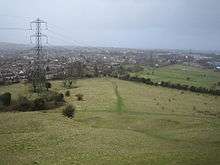 |
62.3 hectares (154 acres) | Dunstable 51°53′13″N 0°29′24″W / 51.887°N 0.490°W TL040220 |
YES | SSSI[13] | The site has varied habitats with a large area of unimproved grassland, which cattle help to maintain. Features include a disused quarry and medieval cultivation terraces. It has a nationally rare plant, Bunium bulbocastanum, and a nationally rare beetle, Odontaeus armiger.[13] |
| Cooper's Hill[14] | 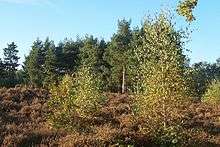 |
12.5 hectares (31 acres) | Ampthill 52°01′37″N 0°30′11″W / 52.027°N 0.503°W TL028376 |
YES | SSSI[15] | The site is described by Natural England as the best surviving example in Bedfordshire of heathland on the thin acidic soils of the Lower Greensand Ridge. It also has areas of marsh and woodland.[15] |
| Cople Pits[16] | 2.0 hectares (4.9 acres) | Cople 52°07′48″N 0°23′24″W / 52.130°N 0.390°W TL103492 |
YES | The site has eleven long water-filled pits from gravel extraction in the 1930s, which are now surrounded by willow and hawthorn scrub. The pits have been colonised by aquatic plants. Fauna include dragonflies, kingfishers and woodpeckers, and there is also a wildflower meadow.[16] | ||
| Cut-throat Meadow[17] | 1.5 hectares (3.7 acres) | Ampthill 52°01′55″N 0°29′06″W / 52.032°N 0.485°W TL039380 |
YES | The reserve is in three separate areas. There is a steeply sloping meadow where meadow saxifrage and field woodrush flower in the spring, a beech and scots pine wood, and a pond which has reedmace and celery-leaved buttercup, and water boatmen and pond skaters on the surface.[17] | ||
| Dropshort Marsh[18] | 2.0 hectares (4.9 acres) | Toddington 51°56′17″N 0°32′13″W / 51.938°N 0.537°W TL007276 |
YES | SSSI[19] | This marsh has a variety of habitats, including a scarce quaking bog. Many species are now uncommon due to changes in agricultural practices. it has several springs, with floating sweet-grass and brooklime and areas dominated by rushes.[19] | |
| Fancott Woods and Meadows[20] | 12.9 hectares (32 acres) | Fancott 51°56′13″N 0°30′36″W / 51.937°N 0.510°W TL025275 |
YES | SSSI[21] | The meadows are mainly ancient ridge and furrow, and are unimproved neutral grassland traditionally managed for hay and grazing. The woodland is mainly ash, with other species including pedunculate oak and alder. There is also a small pond.[21] | |
| Felmersham Gravel Pits[22] | 21.0 hectares (52 acres) | Felmersham 52°12′54″N 0°33′04″W / 52.215°N 0.551°W SP991584 |
YES | SSSI[23] | The site has flooded gravel pits, neutral grassland, scrub and broadleaved woodland.[23] It is described by the Wildlife Trust as one of the best sites in Bedfordshire for dragonflies and damselflies.[22] | |
| Flitwick Moor (& Folly Wood)[24] | 66.6 hectares (165 acres) | Flitwick 52°00′25″N 0°28′37″W / 52.007°N 0.477°W TL046354 |
YES | SSSI[25] | This is a rich valley mire, and the largest area of wetland in Bedfordshire. Eight species of sphagnum bog moss have been recorded, including one which is nationally rare. There are areas of woodland as well as wet grassland.[25] | |
| King's Wood and Rammamere Heath[26] | 104.0 hectares (257 acres) | Heath and Reach 51°57′22″N 0°39′47″W / 51.956°N 0.663°W SP920294 |
YES | SSSI[27] NNR[27] | The site has the largest remaining area of woodland in Bedfordshire, together with lowland heath, acidic grassland and some small ponds. There are a number of rare plant species, including great woodrush, wood vetch and saw-wort.[27] | |
| Lancot Meadow[28] | 2.0 hectares (4.9 acres) | Dunstable 51°53′06″N 0°32′38″W / 51.885°N 0.544°W TL003217 |
YES | The site is a grassland remnant on chalk soil, and a remnant of flower-rich meadows in the area. Flora include common spotted-orchids, ox-eye daisys and bird's foot trefoils. There are fauna such as song thrushes and marbled white butterflies.[28] | ||
| Landpark Wood[29] | 3.6 hectares (8.9 acres) | Whipsnade 51°51′18″N 0°31′34″W / 51.855°N 0.526°W TL016184 |
YES | This wood has mature beech trees, hornbeam, oak and ash. The understorey is hazel and hawthorn, with bluebells, yellow archangel and woodruff. Birds include woodpeckers and nuthatches.[29] | ||
| Old Warden Tunnel[30] | 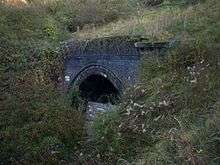 |
3.8 hectares (9.4 acres) | Old Warden 52°05′20″N 0°22′34″W / 52.089°N 0.376°W TL113446 |
YES | The site has oak and ash woodland with mature blackthorn and hawthorn bushes, and a steep cutting with grassland and scrub. Flowers include dwarf thistle and pyramidal orchid, and the scrub provides nesting sites for birds.[30] | |
| Pavenham Osier Beds[31] | 1.3 hectares (3.2 acres) | Pavenham 52°11′06″N 0°33′11″W / 52.185°N 0.553°W SP990551 |
YES | This wet meadow next to the River Great Ouse has the uncommon flower meadow-rue. Osier is a type of willow which is continually cut, stimulating its growth and supplying material for basket weavers. The Trust is continuing the tradition by planting more osiers.[31] | ||
| Pegsdon Hills and Hoo Bit[32] | 79.0 hectares (195 acres) | Pegsdon 51°57′11″N 0°22′19″W / 51.953°N 0.372°W TL120295 |
YES | SSSI,[33] CAONB[32] | The site has wildflower meadows in chalk hills, including orchids and moschatels. There are butterflies such as dingy and grizzled skippers, Birds include wheatears and skylarks, and herbs such as marjoram and wild thyme. Hoo Bit is a flower meadow surrounded by woodland.[32] | |
| Riddy, TheThe Riddy[34] | 7.7 hectares (19 acres) | Sandy 52°07′30″N 0°17′46″W / 52.125°N 0.296°W TL165487 |
YES | LNR[35] | This is one of the few surviving water meadows in the flood plain of the River Ivel. Aquatic plants include celery leaved buttercup and water plantain, and there are birds such as lapwings, fieldfares and redwings. Water voles are found along the river.[35] | |
| Sallowsprings[36] | 1.3 hectares (3.2 acres) | Whipsnade 51°51′14″N 0°32′17″W / 51.854°N 0.538°W TL008183 |
YES | This site was formerly a caravan park, and it is now a traditional hay meadow. A rich variety of flowers includes common knapweed, bluebells and cowslips. An ancient hedgerow has diverse shrubs such as holly.[36] | ||
| Sewell Cutting[37] | 3.6 hectares (8.9 acres) | Dunstable 51°53′38″N 0°32′49″W / 51.894°N 0.547°W TL005226 |
YES | The banks of this former railway cutting provide a rich habitat for chalk grassland flowers, such as common spotted orchids and cowslips. The south-facing slope has deep rooted plants such as hawkweed and scabious, while the sheltered north-facing slope has lush grasses. There are many species of butterflies.[37] | ||
| Sharnbrook Summit[38] | 9.0 hectares (22 acres) | Sharnbrook 52°15′00″N 0°34′37″W / 52.250°N 0.577°W SP972622 |
YES | The site is a mile long narrow strip above a rail tunnel. The reserve is grassland, grazed by rabbits, on limestone deposited during the construction of the railway. The dominant plant is tor-grass, and flowers include dyer's greenweed and wild liquorice. Scattered scrub provides food and shelter from kestrels and buzzards for small mammals and nesting birds.[38] | ||
| Totternhoe[39] | 31.0 hectares (77 acres) | Totternhoe 51°53′06″N 0°34′08″W / 51.885°N 0.569°W SP986217 |
YES | SSSI,[40] LNR,[41] CAONB,[42] | Part of the site was formerly quarry workings for Totternhoe Stone, a strong chalk that was used in Westminster Abbey. It is now grassland with a rich variety of plant species, including some that are now rare. There are a number of orchids and a wide variety of invertebrates, including butterflies such as the common blue, chalkhill blue, and the scarce small blue and Duke of Burgundy.[39][40][41] | |
| Wymington Meadow[38] | 1.0 hectare (2.5 acres) | Wymington 52°15′32″N 0°35′46″W / 52.259°N 0.596°W SP958632 |
YES | The site is a triangular meadow in the corner where two railway lines merge. It was cut off when the railways were constructed in the 1850s, and at the northern end there are traces of the medieval ridge and furrow method of ploughing. The site has a wide range of flowers, such as cowslip, salad burnet and quaking grass. A small stream and hedgerows provide additional habitats for wildlife.[38] |
Cambridgeshire reserves
| Site | Photograph | Area[lower-alpha 1] | Location[lower-alpha 1] | Public access | Desig nations |
Description |
|---|---|---|---|---|---|---|
| Arthur's Meadow[43] | 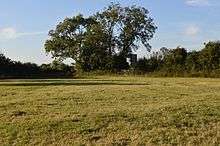 |
0.8 hectares (2.0 acres) | Hemingford Grey 52°18′22″N 0°06′29″W / 52.306°N 0.108°W TL292692 |
YES | SSSI[44] | The site is calcareous clay pasture with a wide variety of plant species, including the herbs oxeye daisy and yellow rattle. There are orchids such as common twayblades and common spotteds.[45] |
| Beechwoods[46] | 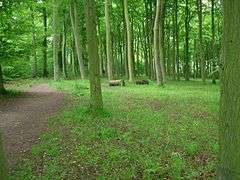 |
10 hectares (25 acres) | Cambridge 52°10′16″N 0°10′12″E / 52.171°N 0.170°E TL485547 |
YES | LNR[47] | Beeches were planted on chalky farmland in the 1840s, and medieval plough terraces are still visible. Birds include green and great spotted woodpeckers, and nuthatches.[46] |
| Brampton Wood[48] |  |
132 hectares (330 acres) | Brampton 52°18′58″N 0°16′12″W / 52.316°N 0.27°W TL184698 |
YES | SSSI[49] | This is one of the few surviving areas of ancient woodland in the county. It is wet ash and maple on heavy clay soil, with rides which have a varied grassland flora, such as yellow pimpernel, greater bird's-foot-trefoil and devil's-bit scabious.[49] |
| Buff Wood[50] | 16 hectares (40 acres) | Hatley 52°08′10″N 0°07′48″W / 52.136°N 0.13°W TL281503 |
WTPR | SSSI[51] | This site is ecologically diverse boulder clay woodland, with a range of wildflowers, including oxlips and the uncommon green hellebore. There are butterflies such as brimstones, large whites, orange-tips and speckled woods.[50] | |
| Cambourne[52] | 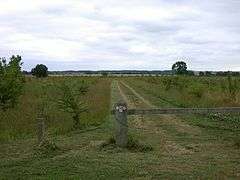 |
90 hectares (220 acres) | Cambourne 52°13′05″N 0°04′30″W / 52.218°N 0.075°W TL316595 |
YES | This site has woodland, lakes, ponds, grassland and an orchard. The lakes and ponds have water voles and great crested newts, and birds include skylarks and corn buntings.[52][53] | |
| Cherry Hinton Chalk Pits[54] | 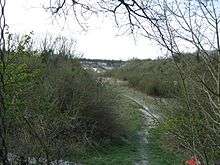 |
11 hectares (27 acres) | Cambridge 52°10′48″N 0°10′05″E / 52.18°N 0.168°E TL483557 |
YES | LNR,[55] SSSI[56] | The two parts of the site are both former chalk quarries. East Pit is surrounded by steep walls of chalk, and the base is wildflower grassland with areas of scrub. Flowers include millkwort, harebell, kidney vetch and the rare moon carrot, which is on the British Red List of Threatened Species. Quarrying ceased 200 years ago in Limekiln Close, and it is now steeply sloping mature woodland with ash and cherry trees.[56][54] |
| Chettisham Meadow[57] | 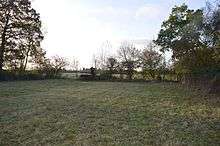 |
0.7 hectares (1.7 acres) | Chettisham 52°25′23″N 0°15′54″E / 52.423°N 0.265°E TL541830 |
YES | SSSI[7] | The site is grassland on calcareous clay, and evidence survives of ridge and furrow medieval farming. Flowering plants include adder's tongue, cowslip and the uncommon green-winged orchid.[7] |
| Doghouse Grove[58] |  |
0.8 hectares (2.0 acres) | Wilburton 52°20′56″N 0°10′19″E / 52.349°N 0.172°E TL480745 |
YES | In the medieval period this was a series of monastic fishponds, which can still be seen in wetter periods. It is now an ash wood, with flowers including bluebells and lords-and-ladies.[58] | |
| Dogsthorpe Star Pit[59] | 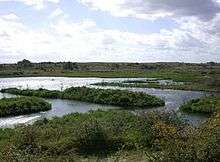 |
37.2 hectares (92 acres) | Peterborough 52°36′29″N 0°12′36″W / 52.608°N 0.21°W TF213026 |
YES | LNR,[60] SSSI[61] | This former brick pit has been designated an SSSI mainly for its invertebrates, especially its water beetles, with 64 species, including four on the IUCN Red List of Threatened Species, Graptodytes bilineatus, Dryops similaris, Gyrinus distinctus and Myopites inulaedyssentericae.[61] |
| Fordham Woods[62] |  |
10 hectares (25 acres) | Fordham 52°18′14″N 0°23′31″E / 52.304°N 0.392°E TL632700 |
YES | SSSI[63] | This wet woodland site has semi-natural alder coppice, with ash, crack willow and silver birch. The ground flora has tall fens, together with herbs such as marsh marigold and yellow flag.[63] |
| Fulbourn Fen[64] |  |
31 hectares (77 acres) | Fulbourn 52°10′41″N 0°13′48″E / 52.178°N 0.230°E TL526557 |
YES | SSSI[65] | These are ancient meadows on calcareous loam and peat which have never been farmed, so they have a rich diversity of flora and fauna. Herbs in drier areas include cowslip and salad burnet, while wetter areas have tall fen vegetation.[65] |
| Gamlingay Cinques[66] |  |
3.4 hectares (8.4 acres) | Gamlingay 52°09′40″N 0°12′32″W / 52.161°N 0.209°W TL226529 |
YES | This site is on dry sandy soil, which is an unusual habitat in the county. Grazing by sheep helps to restore the acid grassland and prevent encroachment by woodland and scrub. flora include slender St John's wort, harebell and devil's bit scabious.[66] | |
| Gamlingay Wood[67] | 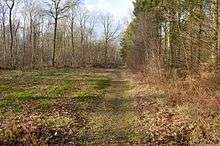 |
70 hectares (170 acres) | Gamlingay 52°10′01″N 0°11′13″W / 52.167°N 0.187°W TL240537 |
YES | SSSI[68] | This is ancient ash/maple woodland on sandy loam soil, an unusual habitat in lowland England. Ground flora include dog's mercury, yellow archangel, wood anemone and the nationally restricted oxlip.[68] The flora is diverse due to the varied soils, and there are hundreds of species of mushrooms and toadstools. Birds include barn owls, garden warblers and blue tits. The site also includes Sugley Wood, which is young woodland.[67][69] |
| Gamsey Wood[70] |  |
4 hectares (9.9 acres) | Woodwalton 52°25′08″N 0°12′04″W / 52.419°N 0.201°W TL225 816 |
YES | The main trees in this wood are ash and field maple, but there are also several wild service trees. Spring flowers include bluebells, wood anemones and yellow archangels, and there are birds such as fieldfares and nightingales.[70] | |
| Godmanchester[71] |  |
59 hectares (150 acres) | Godmanchester 52°19′44″N 0°09′14″W / 52.329°N 0.154°W TL258717 |
PP | The site has four former gravel pits which are now lakes, together with areas of grassland, willow woodland and reedbeds. Birds include wigeons, tufted ducks, teals and great crested grebes, and there are insects such as dragonflies and butterflies.[71] | |
| Grafham Water[72] |  |
114 hectares (280 acres) | Grafham 52°17′24″N 0°19′34″W / 52.290°N 0.326°W TL143 671 |
YES | SSSI[73] | Grafham Water is a reservoir, and the nature reserve is at its western end. It has open water, woodland, grassland and reedbeds. Around 170 bird species have been recorded including greylag geese, mallards and rare birds such as ospreys.[72] |
| Great Fen[74] |  |
1,184 hectares (2,930 acres)[lower-alpha 2] | Holme 52°29′10″N 0°13′26″W / 52.486°N 0.224°W TL207890 |
PP | This is a large wetland project which covers National Nature Reserves run by Natural England, and areas managed by the Trust. The fields of New Decoy Farm are being made wildlife friendly with new ditches and scrapes, and grazing cattle. Rymes Reedbeds is also being restored with new reedbeds on open water. Kesters Docking is being sown as species-poor grassland, and it will also have areas of open water and reedbeds.[75] | |
| Hardwick Wood[76] |  |
15 hectares (37 acres) | Caldecote 52°12′14″N 0°01′02″W / 52.204°N 0.0172°W TL356580 |
YES | SSSI[77] | This medieval wood is now managed by coppicing. It is mainly ash and field maple, while the oldest parts have pedunculate oak with an understorey of hazel and hawthorn, while ground flora include early-purple orchid and yellow archangel.[76][77] |
| Hayley Wood[78] |  |
52 hectares (130 acres) | Great Gransden 52°09′36″N 0°06′47″W / 52.160°N 0.113°W TL292530 |
YES | NCR,[79] SSSI[80] | The soil in this wood is heavy and often waterlogged, conditions which suit meadowsweet and oxlip. The numbers of oxlip declined from around 2 million to 250,000 due to the pressure of excessive numbers of deer, but they have revived since the construction of a fence in 2002. A parish boundary fence is estimated to date from the eleventh century or earlier, and the site has high wildlife value.[80][81] |
| Houghton Meadows[82] | 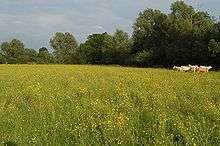 |
8 hectares (20 acres) | Houghton 52°19′41″N 0°06′14″W / 52.328°N 0.104°W TL293717 |
YES | SSSI[83] | Some of these fields are pasture and others are hay meadows, and they display ridges and furrows from medieval ploughing. They are a type of neutral grassland which is declining nationally. Flowers include cowslips and yellow-rattles, and there are fauna such as green woodpeckers and great crested newts.[82][83] |
| Lady's Wood[84] |  |
7.1 hectares (18 acres) | Upwood 52°25′37″N 0°10′23″W / 52.427°N 0.173°W TL243826 |
YES | This wood was a traditional coppice, but many of the trees were cut down in the 1950s. Birds include blackcaps, fieldfares and green woodpeckers and there are invertebrates such as orange-tip butterflies and azure damselflies.[84] | |
| Lattersey[85] | 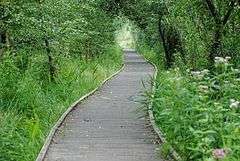 |
11.3 hectares (28 acres) | Whittlesey 52°33′07″N 0°06′40″W / 52.552°N 0.111°W TL282966 |
YES | LNR[86] | This former clay brick quarry has pits which have filled with water, and it has diverse habitats of grassland, woodland, scrub, pools, marshes and reedbeds. Mammals includes water voles, water shrews, and there are birds such as sedge warblers, tawny owls, woodcocks, great spotted woodpeckers and reed buntings.[85][86] |
| Lower Wood[87] |  |
9 hectares (22 acres) | Weston Colville 52°09′00″N 0°22′26″E / 52.150°N 0.374°E TL625528 |
YES | This ancient woodland has a variety of flora such as oxlips and early-purple orchids in the spring and water avens and germander speedwells in the summer. Muntjac and roe deer use the site and birds include goldcrests, great spotted woodpeckers and tawny owls.[87] | |
| Norwood Road[88] |  |
2.6 hectares (6.4 acres) | March 52°33′40″N 0°05′20″E / 52.561°N 0.089°E TL417980 |
YES | This site has a deep pond, marshland and hawthorn scrub. There are wetland birds such as coots, moorhens and mallards, and other wildlife includes noctule bats and weasels.[88] | |
| Ouse Washes[89] |  |
186 hectares (460 acres) | Little Downham 52°27′07″N 0°09′43″E / 52.452°N 0.162°E TL470860 |
YES | NCR,[90] Ramsar,[91] SAC,[92] SPA,[93] SSSI[6] | The Washes are internationally significant for wintering and breeding wildfowl and waders, especially teal, pintails, wigeons, shovelers, pochards and Bewick's swans. The site also has rich aquatic fauna and flora, and areas of unimproved grassland.[6] |
| Overhall Grove[94] |  |
17 hectares (42 acres) | Knapwell 52°15′00″N 0°02′35″W / 52.250°N 0.043°W TL337631 |
YES | NCR,[95] SSSI[96] | This site is the largest elm woodland in the county. It was seriously affected by Dutch elm disease, but many trees have regenerated from their bases, and the mixture of new growth and dead wood provides a very good habitat for insects and birds.[94] |
| Pingle Cutting[97] | 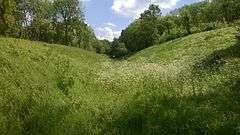 |
1.0 hectare (2.5 acres) | Warboys 52°25′01″N 0°04′12″W / 52.417°N 0.070°W TL313816 |
YES | This former railway cutting has grassland with ox-eye daisy, salad burnet, wild carrot and hairy violet. There is also woodland with forest plants such as bluebells and dog's mercury. Over 50 bird and 300 moth species have been recorded.[97] | |
| Raveley Wood[98] |  |
5.6 hectares (14 acres) | Upwood 52°25′08″N 0°10′19″W / 52.419°N 0.172°W TL244817 |
YES | Trees in this wood include oak, ash and field maple, together with some elms, although many were killed by Dutch elm disease. Invertebrates include the rare white-spotted pinion moth, which depends on elms for food for its larvae, and white-letter hairstreak butterflies. The dead elms provide a habitat for a wide variety of fungi.[98] | |
| Roswell Pits[99] |  |
8 hectares (20 acres) | Ely 52°24′04″N 0°17′10″E / 52.401°N 0.286°E TL556806 |
YES | GCR,[100] SSSI[101][102] | These former clay pits have lakes and reedbeds. Birds include common terns, kingfishers and reed warblers, there are flowers such as bee orchids and insects such as emperor dragonflies. The site has yielded fossils of dinosaurs, crocodiles and turtles.[99] |
| Shepherd's Close[103] |  |
1.2 hectares (3.0 acres) | Spaldwick 52°19′23″N 0°20′20″W / 52.323°N 0.339°W TL133707 |
YES | This small wood was planted in 1984 with ash, field maple and oak. Birds include blackcaps and chiffchaffs, and there are peacock, orange-tip and speckled wood butterflies.[36] | |
| Shepreth L Moor[104] |  |
7.3 hectares (18 acres) | Shepreth 52°06′29″N 0°01′16″E / 52.108°N 0.021°E TL385475 |
YES | SSSI[105] | This is unploughed calcareous grassland which has diverse flora such as horseshoe vetch and felwort in drier areas, and devil's bit scabious and fen bedstraw in wetter ones. The site is regarded by Natural England as valuable for its invertebrates.[104][105] |
| Skaters' Meadow[106] | 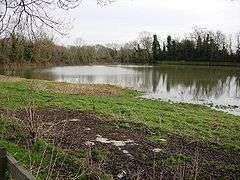 |
2 hectares (4.9 acres) | Cambridge 52°11′31″N 0°06′18″E / 52.192°N 0.105°E TL440569 |
NO | The meadow is flower-rich wet grassland. Flora include common spotted orchids, cuckooflowers, meadowsweets, marsh-marigolds and ragged-robins. There are also grass snakes and birds such as blackcaps.[106] | |
| Soham Meadow[107] |  |
3.6 hectares (8.9 acres) | Soham 52°19′44″N 0°21′36″E / 52.329°N 0.360°E TL609727 |
YES | SSSI[108] | This site is neutral grassland with diverse fauna and flora, including uncommon ones. Wetter areas have herbs such as green-winged orchids and adder’s tongue fern, and there are cowslips and stemless thistles in drier parts. Snipe breed in wet pastures.[108] |
| Southorpe Meadow[109] | 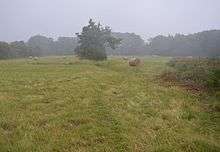 |
2.0 hectares (4.9 acres)[110] | Southorpe 52°36′54″N 0°24′07″W / 52.615°N 0.402°W TF083031 |
YES | SSSI[110] | This is one of the few surviving areas of neutral grassland in the county, where ridge and furrow from medieval ploughing can be seen. There is a rich variety of species, such as red fescue in drier areas, and salad burnet in damper ones.[110] |
| Southorpe Paddock[111] |  |
1.6 hectares (4.0 acres)[112] | Southorpe 52°36′25″N 0°24′04″W / 52.607°N 0.401°W TF084022 |
YES | SSSI[113] | This site is a rare example of unimproved grassland on the Jurassic limestone of eastern England. It has typical limestone plants such as purple milk-vetch and clustered bellflower. Mature hedgerows provide additional habitats for wildlife.[113] |
| Stanground Newt Ponds[114] | 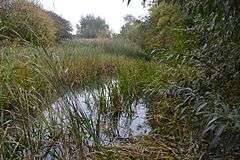 |
0.8 hectares (2.0 acres) | Peterborough 52°32′56″N 0°13′44″W / 52.549°N 0.229°W TL202961 |
YES | This site has ponds and a wet meadow, with smooth and great crested newts. Other fauna include common frogs, damselflies and dragonflies.[114] | |
| Stanground Wash[115] |  |
26 hectares (64 acres) | Peterborough 52°33′43″N 0°13′08″W / 52.562°N 0.219°W TL208975 |
NO | The site is sandwiched between the East Coast Main Line railway line and Back River, a tributary of the River Nene. It is grassland which is flooded in winter, providing a refuge for waterbirds, and is grazed in the summer. It has a variety of birds such as lapwings, snipe, redshanks and skylarks, and ditches with rare beetles.[115] | |
| Thorpe Wood[116] |  |
10 hectares (25 acres) | Peterborough 52°34′16″N 0°17′31″W / 52.571°N 0.292°W TL158983 |
YES | This is ancient woodland on heavy clay, with mature oak and ash trees, and an understorey of hazel and field maple. The ground flora is diverse, including wild garlic, wood anemones and bluebells.[116] | |
| Trumpington Meadows[117] |  |
58 hectares (140 acres) | Trumpington 52°10′12″N 0°06′11″E / 52.170°N 0.103°E TL439545 |
YES | This site has flower meadows, woodland, ponds, and is adjacent to the River Cam and Byron's Pool, where Lord Byron once swam. Fauna include otters, brown hares, muntjac deer, skylarks, lapwings, yellowhammers and meadow pipits.[117] | |
| Upwood Meadows[118] |  |
6 hectares (15 acres) | Upwood 52°25′34″N 0°09′43″W / 52.426°N 0.162°W TL251825 |
YES | NCR,[119] NNR,[120] SSSI[121] | The site has three fields on calcareous clay with poor drainage, a type of pasture now very rare, and was described by Derek Ratcliffe as having "an outstandingly rich and diverse flora".[119] Other habitats are mature hedgerows, ponds and scrub. One of the fields is agriculturally unimproved, and the evidence of medieval ridge and furrow still survives. Flowering plants include pepper saxifrage and green-winged orchid.[122] |
| Wansford Pasture & Standen's Pasture[123] |  |
7.3 hectares (18 acres)[123] | Wansford 52°34′55″N 0°25′26″W / 52.582°N 0.424°W TL069994 |
YES | SSSI[124] | This is a south-facing slope, with Jurassic limestone grassland and a flush lower down which has a wide variety of wet-loving plants, including some which are rare in the county. The ecology is maintained by avoiding the use of fertilisers and herbicides, and by grazing.[124] |
| Waresley and Gransden Woods[125] | 50 hectares (120 acres) | Waresley 52°10′37″N 0°09′25″W / 52.177°N 0.157°W TL261548 |
YES | SSSI[126] | This ancient woodland is mainly ash, field maple and hazel. There are also rides with diverse flora such as the herbs bush vetch, meadowsweet, greater burnet-saxifrage and self-heal.[127] | |
| Wistow Wood[128] | 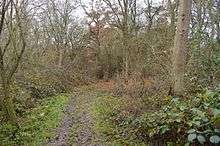 |
8.5 hectares (21 acres) | Wistow 52°25′16″N 0°05′46″W / 52.421°N 0.096°W TL296820 |
YES | SSSI[129] | This wood has many old ash coppices, most of which were cut at ground level in the 1920s and left to re-grow. There are flowering plants such as meadowsweet and ragged-robin, and butterflies include purple hairstreaks and red admirals.[128] |
| Woodston Ponds[130] |  |
10 hectares (25 acres) | Peterborough 52°33′58″N 0°16′05″W / 52.566°N 0.268°W TL175979 |
YES | LNR[131] | The site was formerly settling ponds to remove washings from sugar beets. The east side has a lake with water birds such as grey herons, tufted ducks and pochards. In the west there is a reedbed which has pools and channels, with great crested newts and unusual species of water beetle.[130] |
| Woodwalton Marsh[132] | 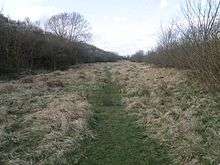 |
1 hectare (2.5 acres) | Woodwalton 52°24′50″N 0°13′08″W / 52.414°N 0.219°W TL212811 |
YES | SSSI[133] | This grassland on calcareous clay has diverse flora, including red fescue, quaking grass, knapweed, cowslip, pepper saxifrage, green-winged orchid and the rare sulphur clover.[133] There is also a wide variety of butterflies.[132] |
Northamptonshire reserves
| Site | Photograph | Area[lower-alpha 1] | Location[lower-alpha 1] | Public access | Desig- nations |
Description |
|---|---|---|---|---|---|---|
| Abington Meadows[134] |  |
9.6 hectares (24 acres) | Northampton 52°14′24″N 0°50′35″W / 52.240°N 0.843°W SP 791 608 |
YES | This is marshy grassland which has diverse wildlife, and 421 species of invertebrates have been recorded. Flora include great burnet, purple loosestrife and the nationally rare pennyroyal. There are birds such as snipe.[134] | |
| Barford Wood and Meadows[135] |  |
36.0 hectares (89 acres) | Rushton 52°26′02″N 0°44′20″W / 52.434°N 0.739°W SP 858 825 |
YES | SSSI[136] | This was formerly part of the medieval Royal Forest of Rockingham. It has diverse habitats, with hay meadows, parkland and recently planted woodland. There are many butterflies such as large skippers, orange-tips, small skippers and small coppers. Mammals include badgers and red foxes.[135] |
| Barnes Meadow[137] |  |
20.0 hectares (49 acres) | Northampton 52°13′48″N 0°52′26″W / 52.230°N 0.874°W SP 770 597 |
YES | LNR[138] | The site includes a stretch of the River Nene, meadows and a redundant arm of the river. There are many dragonflies including brown hawkers, and a large population of grass snakes. Birds include grey herons, kingfishers and great crested grebes.[138][137] |
| Boddington Meadow[139] |  |
2.3 hectares (5.7 acres) | Boddington 52°10′26″N 1°16′48″W / 52.174°N 1.280°W SP 494 531 |
YES | This meadow has never been ploughed and it is managed in a traditional way to encourage uncommon plants, such as great burnet and pepper-saxifrage. There are amphibians including frogs and toads, and butterflies including meadow browns, orange-tips, peacocks, ringlets and small tortoiseshells.[139] | |
| Bradlaugh Fields[140] |  |
17.5 hectares (43 acres) | Northampton 52°16′05″N 0°52′48″W / 52.268°N 0.880°W SP 765 639 |
YES | LNR[141][142] | Bradlaugh Fields nature reserve consists of three fields which are part of the 60 hectare Bradlaugh Fields wildlife park, which is named after the leading radical and atheist, Charles Bradlaugh, who was MP for Northampton. It has ancient hedgerows and unimproved grassland. Birds include blue tits, chiffchaffs, great spotted woodpeckers, sparrowhawks, redwings and fieldfares.[143][140] |
| Bugbrooke Meadow[144] |  |
1.7 hectares (4.2 acres) | Nether Heyford 52°13′19″N 1°01′05″W / 52.222°N 1.018°W SP 672 586 |
YES | SSSI[145] | This is a field on the bank of the River Nene which has not been treated with fertilisers, and often floods in winter. It has very diverse damp grassland flora such as hard rush, jointed rush and greater pond sedge. There are ancient hedges are important both as a habitat for wildlife and historically.[146] |
| Byfield Pool[147] |  |
4.0 hectares (9.9 acres) | Byfield 52°10′12″N 1°16′08″W / 52.170°N 1.269°W SP 501 527 |
YES | This secluded pool, which is adjacent to the Boddington Reservoir, was constructed in the 1790s to supply water to the Oxford Canal. Water rails and tufted ducks breed on the pond, and there are many frogs and other amphibians. A wide range of other birds nest in the adjacent scrub and woods. Mammals include rabbits and red foxes.[147] | |
| Collyweston Quarries[148] |  |
8.0 hectares (20 acres) | Easton on the Hill 52°37′23″N 0°31′08″W / 52.623°N 0.519°W TF 003 038 |
YES | SSSI[149] | This former limestone quarry is now rough grassland on Jurassic limestone. The flora is diverse, and more than a hundred flowering plants have been recorded, including wild thyme, dropwort, dyer's greenweed and clustered bellflower. There is a substantial butterfly population.[149] |
| Ditchford Lakes and Meadows[150] | 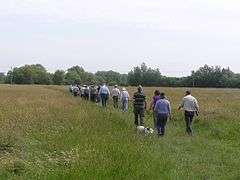 |
31.1 hectares (77 acres) | Higham Ferrers 52°18′00″N 0°38′17″W / 52.300°N 0.638°W SP 930 678 |
YES | Ramsar,[151] SPA,[152] SSSI[153][154] | This site has lakes in old gravel pits which are used by wintering and breeding birds such as Cetti's warblers, coots, oystercatchers and grey herons. The lakes are also visited by otters. There are areas of grassland and willow scrub.[150] |
| Duston Mill Meadow[155] |  |
1.0 hectare (2.5 acres) | Northampton 52°13′52″N 0°55′59″W / 52.231°N 0.933°W SP 729 597 |
YES | This wet meadow on the bank of the River Nene is described by the Trust as important for dragonflies and butterflies. It has muddy areas where wading birds such as snipe and the uncommon water rail feed on invertebrates.[155] | |
| Farthinghoe[156] |  |
4.0 hectares (9.9 acres) | Farthinghoe 52°03′32″N 1°14′46″W / 52.059°N 1.246°W SP 518 403 |
YES | LNR[157] | This former landfill site has grassland, ponds and woodland. Flowers include lady's bedstraw, meadow vetchling and snake's-head fritillary. There are fauna such as marbled white and green-veined white butterflies, and pipistrelle and noctule bats.[157][156] |
| Finedon Cally Banks[158] |  |
2.5 hectares (6.2 acres) | Wellingborough 52°19′52″N 0°40′41″W / 52.331°N 0.678°W SP 902 712 |
YES | The site was formerly used to burn ironstone to remove impurities, leaving a layer of calcine, which produces poor soil in which wildflowers flourish. The reserve also includes a stretch of railway embankment for transporting the iron ore. Flora include common spotted orchids, great reedmace, kidney vetch and meadowsweet.[158] | |
| Glapthorn Cow Pastures[159] |  |
28.0 hectares (69 acres) | Oundle 52°30′00″N 0°31′08″W / 52.500°N 0.519°W TL 006 902 |
YES | SSSI[160] | This site has ash and maple woodland, and dense blackthorn scrub. It is described by Natural England as one of the most important sites in Britain for the black hairstreak butterfly, which requires a habitat of Prunus species such as blackthorn. The scrub also provides nesting sites for nightingales.[160] |
| Grafton Regis Meadow[161] | 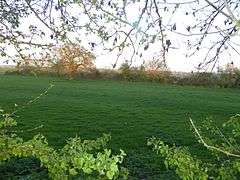 |
2.0 hectares (4.9 acres) | Towcester 52°06′47″N 0°53′06″W / 52.113°N 0.885°W SP 771 463 |
NO | This is a traditionally managed hay meadow on the bank of the Grand Union Canal. Birds visiting the site include curlews, lapwings, long-tailed tits, bullfinches, yellowhammers and wrens.[161] | |
| Great Oakley Meadow[162] |  |
2.0 hectares (4.9 acres) | Great Oakley 52°27′43″N 0°43′52″W / 52.462°N 0.731°W SP 863 856 |
YES | LNR[163] | The prominent medieval ridge and furrow at the southern end of the site displays the ancient field system of Great Oakley. The dry ridges have diverse flora including cowslip, knapweed and quaking-grass. The furrows are poorer in species, while the northern end, which borders Harpers Brook, has plants characteristic of wet ground, such as cuckooflower and hairy sedge. The field is bordered by hedges, which provide seeds and insects for birds.[162] |
| Harlestone Heath[164] |  |
2.6 hectares (6.4 acres) | Northampton 52°16′30″N 0°56′42″W / 52.275°N 0.945°W SP 721 646 |
YES | The site is two narrow strips on either side of the Northampton loop railway line between Northampton and Rugby, with a tunnel connecting the strips. A stream runs along the north-east boundary. It is acid heathland, which is rare in the county. Birds include green woodpeckers and siskins, and there are butterflies such as brown arguses and speckled woods.[164] | |
| High Wood and Meadow[165] | 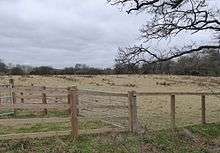 |
16.5 hectares (41 acres) | Daventry 52°11′17″N 1°08′02″W / 52.188°N 1.134°W SP 593 548 |
YES | SSSI[166] | The wood is ancient and semi-natural on acid soils. It has diverse ground flora, including yellow pimpernel, hairy wood-rush and broad-leaved helleborine. The meadow is acid grassland of a type which is now uncommon, and there are also areas of neutral grassland and marsh on silty peat. There are many ant hills of the yellow meadow ant.[166] |
| Higham Ferrers Pits[167] |  |
10.0 hectares (25 acres) | Higham Ferrers 52°18′32″N 0°36′32″W / 52.309°N 0.609°W SP 949 688 |
YES | Ramsar,[151] SPA,[152] SSSI[153][154] | This narrow strip of grassland next to the River Nene is a refuge for breeding and wintering birds such as little grebes, shovelers, reed warblers, gadwalls and reed buntings. There are diverse damselflies and dragonflies.[167] |
| Irthlingborough Lakes and Meadows[168] | 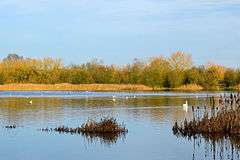 |
117.0 hectares (289 acres) | Irthlingborough 52°19′05″N 0°36′29″W / 52.318°N 0.608°W SP 950 698 |
YES | Ramsar,[151] SPA,[152] SSSI[153][154] | This reserve on the banks of the River Nene has wintering golden plovers, wigeons and gadwalls, and there are invertebrates such as banded demoiselle damselflies and common darter dragonflies. Meadows have grass snakes, and pipistrelle and noctule bats hunt insects at night.[168] |
| King's Wood[169] |  |
32.0 hectares (79 acres) | Corby 52°28′34″N 0°43′34″W / 52.476°N 0.726°W SP 866 872 |
YES | LNR[170] | More than 250 plant species have been recorded at this remnant of the Royal Forest of Rockingham, including ones characteristic of ancient woods including yellow archangel and wood anemone. There are diverse invertebrates such as green-veined white butterflies and common blue damselflies, and birds include treecreepers, long-tailed tits, green woodpeckers and tawny owls.[170][169] |
| Kingsthorpe Meadow[171] | 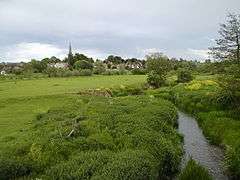 |
15.0 hectares (37 acres) | Northampton 52°15′25″N 0°54′29″W / 52.257°N 0.908°W SP 746 627 |
YES | LNR[172] | This site on the Brampton arm of the River Nene is often flooded in the winter. There are hedges and ponds, together with areas of scrub. Birds include green woodpeckers, kestrels and snipe.[171] |
| Lings[173] | 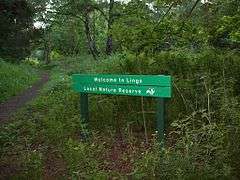 |
18.5 hectares (46 acres) | Northampton 52°16′01″N 0°49′30″W / 52.267°N 0.825°W SP 803 639 |
YES | LNR[174] | Frogs, newts, damselflies and dragonflies breed in this nature reserve, which has woodland, ponds, scrub and grassland. There are plantations of sweet chestnut and douglas fir, but in some areas native woodland is regenerating naturally.[173] |
| Mill Crook[161] | 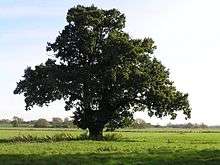 |
5.9 hectares (15 acres) | Towcester 52°06′36″N 0°52′34″W / 52.110°N 0.876°W SP 771 463 |
WTPR | SSSI[175] | Signs of medieval ridge and furrow still survive on this traditionally hay meadow on the bank of the River Tove. It has diverse flora, with grasses such as meadow foxtail and sweet vernal-grass, and herbs including great burnet and ribwort plantain.[175][161] |
| Old Sulehay[176] |  |
85.0 hectares (210 acres) | King's Cliffe 52°34′26″N 0°26′02″W / 52.574°N 0.434°W TL 062 985 |
YES | SSSI[177] | This ancient forest has a number of different soil conditions and coppice types, and the ground flora is diverse. Abundant herbs include dog’s mercury, bracken, bramble, ramsons, wood anemone and bluebells.[177] |
| Pitsford Water[178] |  |
181.0 hectares (447 acres) | Brixworth 52°19′19″N 0°50′49″W / 52.322°N 0.847°W SP 787 699 |
WTPR | SSSI[179] | This reservoir has been designated an SSSI mainly because of its many wildfowl, and the Trust manages the northern end for wildlife. In summer, falling water levels expose mud which provides feeding grounds for migrating waders, and winter visitors include wigeons, gadwall, pintails and teals.[178] |
| Plens, TheThe Plens[180] |  |
5.0 hectares (12 acres) | Desborough 52°26′49″N 0°48′40″W / 52.447°N 0.811°W SP 809 839 |
YES | Former use as a quarry and a railway line have created steep slopes and varied habitats, with grassland, hawthorn scrub, woodland and herbs. Flowers include wild basil, bladder campion, moschatel and bird's-foot-trefoil. There is a diverse range of invertebrates, particularly butterflies.[181] | |
| Ramsden Corner[182] | 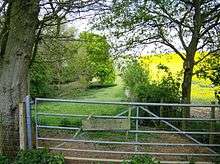 |
3.2 hectares (7.9 acres) | Weedon Bec 52°12′11″N 1°05′20″W / 52.203°N 1.089°W SP 623 564 |
YES | SSSI[183] | A stream runs through this valley site, which is acidic grassland, woodland and scrub on clay and sand. Plants such as wood millet, wood-sorrel and wood vetch are indicators of ancient woodland. Opposite-leaved golden-saxifrage is found in wet flushes.[183] |
| Rothwell Gullet[184] | 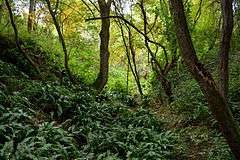 |
1.6 hectares (4.0 acres) | Rothwell 52°25′41″N 0°48′54″W / 52.428°N 0.815°W SP 807 818 |
YES | This former ironstone quarry has woodland, grassland and damp undergrowth with fungi. Hart's-tongue fern lines the quarry walls, and mammals include badgers and red foxes. A patch of privet provides a habitat for butterflies such as small heaths and green hairstreaks.[184] | |
| Short Wood and Southwick Wood[185] |  |
54.7 hectares (135 acres) | Oundle 52°31′N 0°29′W / 52.51°N 0.49°W TL 023 914 |
YES | SSSI[186] | The site is a small remnant of the medieval royal hunting Rockingham Forest. Short Wood is ancient semi-natural woodland with the dominant trees being ash and pedunculate oak. Flora include several local rarities such as wood speedwell, bird's nest orchid and greater butterfly orchid.[186] Southwick Wood lost its elms in the late 1960s due to Dutch elm disease, and it now has oak, ash, field maple and hazel.[185] |
| Southfield Farm Marsh[187] |  |
2.8 hectares (6.9 acres) | Barton Seagrave 52°22′26″N 0°42′00″W / 52.374°N 0.700°W SP 886 759 |
YES | SSSI[188] | The wetland has tall plants such as lesser pond-sedge and slender tufted-sedge, which provides cover for reed buntings and sedge warblers. Mammals include otters, and there are birds such as red kites and buzzards. Purple loosestrife is found in grassland areas.[187] |
| Stoke Bruerne Brick Pits[189] |  |
6.0 hectares (15 acres) | Stoke Bruerne 52°08′20″N 0°54′50″W / 52.139°N 0.914°W SP 744 495 |
YES | This former brickworks was opened at the end of the eighteenth century for the construction of the Grand Junction Canal, and is on its bank. There are diverse habitats with grassland, ponds, a reed bed and a redundant arm of the canal. Invertebrates include white-legged damselflies and there are a variety of small mammals which provide food for barn owls.[189] | |
| Stoke Wood End Quarter[190] | 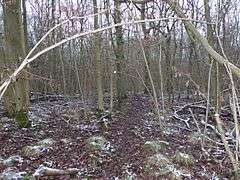 |
0.7 hectares (1.7 acres) | Corby 52°27′54″N 0°43′26″W / 52.465°N 0.724°W SP 800 859 |
YES | SSSI[8] | The main trees in this wood are oak, ash, hazel and blackthorn. There are flowers such as early purple orchid and twayblade, birds including treecreepers and tawny owls, while comma and small tortoiseshell butterflies feed in open glades in summer.[190] |
| Storton's Pits[155] |  |
22.0 hectares (54 acres) | Northampton 52°14′02″N 0°55′48″W / 52.234°N 0.930°W SP 732 600 |
YES | LNR[191] | This site on the bank of the River Nene has old gravel pits, meadow and fen ditch. Around 350 invertebrate species have been recorded, including some which are rare. Water birds include snipe, teal, tufted duck and the uncommon water rail.[191][155] |
| Summer Leys[192] | 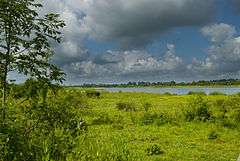 |
47.0 hectares (116 acres) | Wollaston 52°15′40″N 0°43′59″W / 52.261°N 0.733°W SP 866 633 |
YES | LNR,[193] Ramsar,[194] SPA[195] SSSI,[153][154] | This wetland site has flooded gravel pits with bird hides, grassland, hedges and water meadows. Breeding birds include golden plovers, ringed plovers and common terns. There are butterflies such as common blues and the uncommon brown argus.[192] |
| Tailby Meadow[196] |  |
5.0 hectares (12 acres) | Desborough 52°26′13″N 0°48′14″W / 52.437°N 0.804°W SP 814 828 |
YES | LNR[197] | Artificial fertilisers have never been used on this hay meadow, and it has not been ploughed for several hundred years. There are fifteen species of grass and diverse wild flowers, including black knapweed, lady's bedstraw and lady's smock, which is a food source for the orange tip butterfly.[198] |
| Titchmarsh[199] |  |
72.0 hectares (178 acres) | Thrapston 52°25′12″N 0°31′19″W / 52.420°N 0.522°W TL 006 812 |
YES | LNR[200] | The River Nene runs through this site, which also has large areas of open water and grassland. There are nationally important numbers of goosanders, wigeons and gadwalls in winter, and banded demoiselle damselflies nest on nettles along the river bank.[199][200] |
| Twywell Hills and Dales[201] |  |
39.0 hectares (96 acres) | Twywell 52°23′06″N 0°37′23″W / 52.385°N 0.623°W SP 938 772 |
PP | SSSI[202] | Part of the site is a former ironstone quarry which has deep cuttings with steeply sloping banks. It has species-rich limestone grassland on the slopes and ponds and scrub in the bottoms. There are a number of uncommon ground nesting bees and wasps, and beetles include the nationally rare ruddy darter.[202] There is a large pond which has a large reedbed and many great crested newts.[201] |
| Wicksteed Park[203] |  |
14.2 hectares (35 acres) | Barton Seagrave 52°23′06″N 0°42′11″W / 52.385°N 0.703°W SP 884 771 |
PP | This site is in two areas, Wicksteed Water Meadows and Castle Field. Water meadows are deliberately flooded for agricultural purposes, unlike flood meadows which are naturally under water when river levels are high. Flora include great burnet and marsh marigold, and there are also grass snakes.[203] | |
| Wilson's Pits[204] | 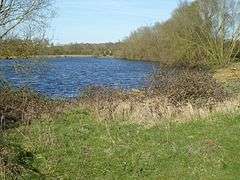 |
32.0 hectares (79 acres) | Higham Ferrers 52°18′07″N 0°37′01″W / 52.302°N 0.617°W SP 944 680 |
YES[lower-alpha 3] | Ramsar,[151] SPA,[152] SSSI[153][154] | This site has three lakes in former gravel pits, and it also has areas of grassland and scrub. There are diverse bird species, and flora such as rageed-robin, brooklime, common spotted orchid and creeping jenny. Dragonflies include the brown hawker and black-tailed skimmer.[204] |
| Woodford Halse[205] |  |
5.7 hectares (14 acres) | Woodford Halse 52°09′40″N 1°12′54″W / 52.161°N 1.215°W SP 538 517 |
YES | This site in two disused railway cuttings has some plant species which are rare in Northamptonshire. Over 100 flower species have been recorded, including knapweed and devil's bit scabious. There are birds such as fieldfare, redwing, wheatear, lesser whitethroat, yellowhammer and linnet.[205] |
| Wikimedia Commons has media related to Wildlife Trust for Bedfordshire, Cambridgeshire and Northamptonshire. |
Notes
- 1 2 3 4 5 6 The area and location are taken from the Wildlife Trust page for each site.
- ↑ The figure for the area of Great Fen includes parts managed by Natural England. The figure for the area managed by the Trust is not available.
- ↑ As of March 2017, Wilson's Pits is closed while roadworks are carried out.
References
- ↑ "Our Trust by numbers". Wildlife Trust for Bedfordshire, Cambridgeshire and Northamptonshire. Retrieved 17 May 2017.
- ↑ "Annual Report & Signed Accounts 2016" (PDF). Wildlife Trust for Bedfordshire, Cambridgeshire and Northamptonshire. Retrieved 17 May 2017.
- ↑ "Our vision, mission and values". Wildlife Trust for Bedfordshire, Cambridgeshire and Northamptonshire. Retrieved 17 May 2017.
- 1 2 "Our History". The Wildlife Trusts. Retrieved 17 May 2017.
- ↑ "Our History". Wildlife Trust for Bedfordshire, Cambridgeshire and Northamptonshire. Retrieved 17 May 2017.
- 1 2 3 "Ouse Washes citation" (PDF). Sites of Special Scientific Interest. Natural England. Retrieved 13 December 2016.
- 1 2 3 "Chettisham Meadow citation" (PDF). Sites of Special Scientific Interest. Natural England. Retrieved 14 November 2016.
- 1 2 "Stoke and Bowd Lane Woods citation" (PDF). Sites of Special Scientific Interest. Natural England. Retrieved 22 December 2016.
- 1 2 "Arlesey Old Moat and Glebe Meadows". Wildlife Trust for Bedfordshire, Cambridgeshire and Northamptonshire. Retrieved 21 March 2016.
- 1 2 "Barton Gravel Pit". Wildlife Trust for Bedfordshire, Cambridgeshire and Northamptonshire. Retrieved 20 December 2015.
- 1 2 "Begwary Brook". Wildlife Trust for Bedfordshire, Cambridgeshire and Northamptonshire. Retrieved 16 December 2015.
- ↑ "Blow's Downs". Wildlife Trust for Bedfordshire, Cambridgeshire and Northamptonshire. Retrieved 24 August 2015.
- 1 2 "Blow's Down citation" (PDF). Sites of Special Scientific Interest. Natural England. Retrieved 24 August 2015.
- ↑ "Cooper's Hill". Wildlife Trust for Bedfordshire, Cambridgeshire and Northamptonshire. Retrieved 24 August 2015.
- 1 2 "Cooper's Hill citation" (PDF). Sites of Special Scientific Interest. Natural England. Retrieved 24 August 2015.
- 1 2 "Cople Pits". Wildlife Trust for Bedfordshire, Cambridgeshire and Northamptonshire. Retrieved 15 December 2015.
- 1 2 "Cut-throat Meadow". Wildlife Trust for Bedfordshire, Cambridgeshire and Northamptonshire. Retrieved 22 September 2015.
- ↑ "Dropshort Marsh". Wildlife Trust for Bedfordshire, Cambridgeshire and Northamptonshire. Retrieved 25 August 2015.
- 1 2 "Dropshort Marsh citation" (PDF). Sites of Special Scientific Interest. Natural England. Retrieved 25 August 2015.
- ↑ "Fancott Woods and Meadows". Wildlife Trust for Bedfordshire, Cambridgeshire and Northamptonshire. Retrieved 25 August 2015.
- 1 2 "Fancott Woods and Meadows citation" (PDF). Sites of Special Scientific Interest. Natural England. Retrieved 25 August 2015.
- 1 2 "Felmersham Gravel Pits". Wildlife Trust for Bedfordshire, Cambridgeshire and Northamptonshire. Retrieved 26 August 2015.
- 1 2 "Felmersham Gravel Pits citation" (PDF). Sites of Special Scientific Interest. Natural England. Retrieved 26 August 2015.
- ↑ "Flitwick Moor (& Folly Wood)". Wildlife Trust for Bedfordshire, Cambridgeshire and Northamptonshire. Retrieved 26 August 2015.
- 1 2 "Flitwick Moor citation" (PDF). Sites of Special Scientific Interest. Natural England. Retrieved 26 August 2015.
- ↑ "King's Wood and Rammamere Heath". Wildlife Trust for Bedfordshire, Cambridgeshire and Northamptonshire. Retrieved 27 August 2015.
- 1 2 3 "Kings and Bakers Woods and Heaths citation" (PDF). Sites of Special Scientific Interest. Natural England. Retrieved 27 August 2015.
- 1 2 "Lancot Meadow". Wildlife Trust for Bedfordshire, Cambridgeshire and Northamptonshire. Retrieved 6 December 2015.
- 1 2 "Landpark Wood". Wildlife Trust for Bedfordshire, Cambridgeshire and Northamptonshire. Retrieved 6 December 2015.
- 1 2 "Old Warden Tunnel". Wildlife Trust for Bedfordshire, Cambridgeshire and Northamptonshire. Retrieved 23 March 2016.
- 1 2 "Pavenham Osier Beds (In Memory of Horace Church)". Wildlife Trust for Bedfordshire, Cambridgeshire and Northamptonshire. Retrieved 23 March 2016.
- 1 2 3 "Pegsdon Hills and Hoo Bit". Wildlife Trust for Bedfordshire, Cambridgeshire and Northamptonshire. Retrieved 16 December 2015.
- ↑ "Map of Deacon Hill". Sites of Special Scientific Interest. Natural England. Retrieved 8 March 2015.
- ↑ "The Riddy". Wildlife Trust for Bedfordshire, Cambridgeshire and Northamptonshire. Retrieved 23 March 2016.
- 1 2 "The Riddy". Local Nature Reserves. Natural England. 19 February 2015. Retrieved 4 October 2015.
- 1 2 3 "Sallowsprings". Wildlife Trust for Bedfordshire, Cambridgeshire and Northamptonshire. Retrieved 6 December 2015.
- 1 2 "Sewell Cutting". Wildlife Trust for Bedfordshire, Cambridgeshire and Northamptonshire. Retrieved 10 September 2015.
- 1 2 3 4 "Sharnbrook Summit and Wymington Meadow". Wildlife Trust for Bedfordshire, Cambridgeshire and Northamptonshire. Retrieved 26 November 2015.
- 1 2 "Totternhoe". Wildlife Trust for Bedfordshire, Cambridgeshire and Northamptonshire. Retrieved 10 September 2015.
- 1 2 "Totternhoe Knolls citation" (PDF). Sites of Special Scientific Interest. Natural England. Retrieved 10 September 2015.
- 1 2 "Totternhoe Knolls". Local Nature Reserves. Natural England. Retrieved 10 September 2015.
- ↑ "Totternhoe Knolls". Chilterns Conservation Board. Retrieved 26 March 2016.
- ↑ "Arthur's Meadow". Wildlife Trust for Bedfordshire, Cambridgeshire and Northamptonshire. Retrieved 27 July 2016.
- ↑ "Hemingford Grey Meadow citation" (PDF). Sites of Special Scientific Interest. Natural England. Retrieved 8 September 2016.
- ↑ "Hemingford Grey Meadow citation" (PDF). Sites of Special Scientific Interest. Natural England. Retrieved 13 September 2016.
- 1 2 "Beechwoods". Wildlife Trust for Bedfordshire, Cambridgeshire and Northamptonshire. Retrieved 27 July 2016.
- ↑ "The Beechwoods". Local Nature Reserves. Natural England. 21 February 2013. Retrieved 16 December 2016.
- ↑ "Brampton Wood". Wildlife Trust for Bedfordshire, Cambridgeshire and Northamptonshire. Retrieved 27 July 2016.
- 1 2 "Brampton Wood citation" (PDF). Sites of Special Scientific Interest. Natural England. Retrieved 28 November 2016.
- 1 2 "Buff Wood". Wildlife Trust for Bedfordshire, Cambridgeshire and Northamptonshire. Retrieved 27 July 2016.
- ↑ "Buff Wood citation" (PDF). Sites of Special Scientific Interest. Natural England. Retrieved 16 December 2016.
- 1 2 "Cambourne". Wildlife Trust for Bedfordshire, Cambridgeshire and Northamptonshire. Retrieved 27 July 2016.
- ↑ "Cambourne Nature Reserve" (PDF). Wildlife Trust for Bedfordshire, Cambridgeshire and Northamptonshire. Retrieved 16 December 2016.
- 1 2 "Cherry Hinton Chalk Pits". Wildlife Trust for Bedfordshire, Cambridgeshire and Northamptonshire. Retrieved 27 July 2016.
- ↑ "Limekiln Close and East Pit Local Nature Reserve". Cambridge City Council. Retrieved 16 January 2017.
- 1 2 "Cherry Hinton Pit citation" (PDF). Sites of Special Scientific Interest. Natural England. Retrieved 30 November 2016.
- ↑ "Chettisham Meadow". Wildlife Trust for Bedfordshire, Cambridgeshire and Northamptonshire. Retrieved 28 July 2016.
- 1 2 "Doghouse Grove". Wildlife Trust for Bedfordshire, Cambridgeshire and Northamptonshire. Retrieved 28 July 2016.
- ↑ "Dogsthorpe Star Pit". Wildlife Trust for Bedfordshire, Cambridgeshire and Northamptonshire. Retrieved 28 July 2016.
- ↑ "Dogsthorpe Star Pit". Local Nature Reserves. Natural England. 20 February 2013. Retrieved 30 November 2016.
- 1 2 "Dogsthorpe Star Pitcitation" (PDF). Sites of Special Scientific Interest. Natural England. Retrieved 30 November 2016.
- ↑ "Fordham Woods". Wildlife Trust for Bedfordshire, Cambridgeshire and Northamptonshire. Retrieved 28 July 2016.
- 1 2 "Brackland Rough citation" (PDF). Sites of Special Scientific Interest. Natural England. Retrieved 28 July 2016.
- ↑ "Fulbourn Fen". Wildlife Trust for Bedfordshire, Cambridgeshire and Northamptonshire. Retrieved 28 July 2016.
- 1 2 "Fulbourn Fen citation" (PDF). Sites of Special Scientific Interest. Natural England. Retrieved 6 December 2016.
- 1 2 "Gamlingay Cinques". Wildlife Trust for Bedfordshire, Cambridgeshire and Northamptonshire. Retrieved 28 July 2016.
- 1 2 "Gamlingay Wood". Wildlife Trust for Bedfordshire, Cambridgeshire and Northamptonshire. Retrieved 28 July 2016.
- 1 2 "Gamlingay Wood citation" (PDF). Sites of Special Scientific Interest. Natural England. Retrieved 16 December 2016.
- ↑ "Welcome to Gamlingay and Sugley Wood" (PDF). Wildlife Trust for Bedfordshire, Cambridgeshire and Northamptonshire. Retrieved 30 January 2017.
- 1 2 "Gamsey Wood". Wildlife Trust for Bedfordshire, Cambridgeshire and Northamptonshire. Retrieved 28 July 2016.
- 1 2 "Godmanchester". Wildlife Trust for Bedfordshire, Cambridgeshire and Northamptonshire. Retrieved 28 July 2016.
- 1 2 "Grafham Water". Wildlife Trust for Bedfordshire, Cambridgeshire and Northamptonshire. Retrieved 28 July 2016.
- ↑ "Grafham Water citation" (PDF). Sites of Special Scientific Interest. Natural England. Retrieved 7 December 2016.
- ↑ "Great Fen". Wildlife Trust for Bedfordshire, Cambridgeshire and Northamptonshire. Retrieved 28 July 2016.
- ↑ "Great Fen". Wildlife Trust for Bedfordshire, Cambridgeshire and Northamptonshire. Retrieved 18 November 2016.
- 1 2 "Hardwick Wood". Wildlife Trust for Bedfordshire, Cambridgeshire and Northamptonshire. Retrieved 28 July 2016.
- 1 2 "Hardwick Wood citation" (PDF). Sites of Special Scientific Interest. Natural England. Retrieved 1 October 2016.
- ↑ "Hayley Wood". Wildlife Trust for Bedfordshire, Cambridgeshire and Northamptonshire. Retrieved 28 July 2016.
- ↑ Ratcliffe, A Nature Conservation Review, p. 56
- 1 2 "Hayley Wood citation" (PDF). Sites of Special Scientific Interest. Natural England. Retrieved 16 December 2016.
- ↑ "Welcome to Hayley Wood" (PDF). Wildlife Trust for Bedfordshire, Cambridgeshire and Northamptonshire. Retrieved 30 January 2017.
- 1 2 "Houghton Meadows". Wildlife Trust for Bedfordshire, Cambridgeshire and Northamptonshire. Retrieved 28 July 2016.
- 1 2 "Houghton Meadows citation" (PDF). Sites of Special Scientific Interest. Natural England. Retrieved 11 December 2016.
- 1 2 "Lady's Wood". Wildlife Trust for Bedfordshire, Cambridgeshire and Northamptonshire. Retrieved 28 July 2016.
- 1 2 "Lattersey". Wildlife Trust for Bedfordshire, Cambridgeshire and Northamptonshire. Retrieved 28 July 2016.
- 1 2 "Lattersey Field". Local Nature Reserves. Natural England. 20 February 2013. Retrieved 15 December 2016.
- 1 2 "Lower Wood". Wildlife Trust for Bedfordshire, Cambridgeshire and Northamptonshire. Retrieved 28 July 2016.
- 1 2 "Norwood Road". Wildlife Trust for Bedfordshire, Cambridgeshire and Northamptonshire. Retrieved 28 July 2016.
- ↑ "Ouse Washes". Wildlife Trust for Bedfordshire, Cambridgeshire and Northamptonshire. Retrieved 28 July 2016.
- ↑ Ratcliffe, A Nature Conservation Review, pp. 138, 172
- ↑ "Information Sheet on Ramsar Wetlands (RIS): Ouse Washes" (PDF). Joint Nature Conservation Committee. Retrieved 13 December 2016.
- ↑ "Ouse Washes SAC". Joint Nature Conservation Committee. Retrieved 13 December 2016.
- ↑ "Special Protection Areas under the EC Birds Directive: Ouse Washes" (PDF). Joint Nature Conservation Committee. Retrieved 13 December 2016.
- 1 2 "Overhall Grove". Wildlife Trust for Bedfordshire, Cambridgeshire and Northamptonshire. Retrieved 28 July 2016.
- ↑ Ratcliffe, A Nature Conservation Review, p. 61
- ↑ "Overhall Grove citation" (PDF). Sites of Special Scientific Interest. Natural England. Retrieved 28 November 2016.
- 1 2 "Pingle Cutting". Wildlife Trust for Bedfordshire, Cambridgeshire and Northamptonshire. Retrieved 27 January 2017.
- 1 2 "Raveley Wood". Wildlife Trust for Bedfordshire, Cambridgeshire and Northamptonshire. Retrieved 28 July 2016.
- 1 2 "Roswell Pits". Wildlife Trust for Bedfordshire, Cambridgeshire and Northamptonshire. Retrieved 28 July 2016.
- ↑ "Roswell Pits, Ely (Jurassic - Cretaceous Reptilia)". Joint Nature Conservation Committee. Retrieved 1 December 2016.
- ↑ "Ely Pits and Meadows citation" (PDF). Sites of Special Scientific Interest. Natural England. Retrieved 28 July 2016.
- ↑ "Map of Ely Pits and Meadows". Sites of Special Scientific Interest. Natural England. Retrieved 28 July 2016.
- ↑ "Shepherd's Close". Wildlife Trust for Bedfordshire, Cambridgeshire and Northamptonshire. Retrieved 28 July 2016.
- 1 2 "Shepreth L Moor". Wildlife Trust for Bedfordshire, Cambridgeshire and Northamptonshire. Retrieved 28 July 2016.
- 1 2 "L-Moor, Shepreth citation" (PDF). Sites of Special Scientific Interest. Natural England. Retrieved 2 October 2016.
- 1 2 "Skaters' Meadow". Wildlife Trust for Bedfordshire, Cambridgeshire and Northamptonshire. Retrieved 28 July 2016.
- ↑ "Soham Meadow". Wildlife Trust for Bedfordshire, Cambridgeshire and Northamptonshire. Retrieved 28 July 2016.
- 1 2 "Soham Wet Horse Fen citation" (PDF). Sites of Special Scientific Interest. Natural England. Retrieved 12 December 2016.
- ↑ "Southorpe Meadow". Wildlife Trust for Bedfordshire, Cambridgeshire and Northamptonshire. Retrieved 28 July 2016.
- 1 2 3 "Southorpe Meadow citation" (PDF). Sites of Special Scientific Interest. Natural England. Retrieved 30 August 2016.
- ↑ "Southorpe Paddock". Wildlife Trust for Bedfordshire, Cambridgeshire and Northamptonshire. Retrieved 28 July 2016.
- ↑ "Designated Sites View: Southorpe Paddock". Sites of Special Scientific Interest. Natural England. Retrieved 30 August 2016.
- 1 2 "Southorpe Paddock citation" (PDF). Sites of Special Scientific Interest. Natural England. Retrieved 30 August 2016.
- 1 2 "Stanground Newt Ponds". Wildlife Trust for Bedfordshire, Cambridgeshire and Northamptonshire. Retrieved 28 July 2016.
- 1 2 "Stanground Wash". Wildlife Trust for Bedfordshire, Cambridgeshire and Northamptonshire. Retrieved 28 July 2016.
- 1 2 "Thorpe Wood". Wildlife Trust for Bedfordshire, Cambridgeshire and Northamptonshire. Retrieved 28 July 2016.
- 1 2 "Trumpington Meadows". Wildlife Trust for Bedfordshire, Cambridgeshire and Northamptonshire. Retrieved 28 July 2016.
- ↑ "Upwood Meadows". Wildlife Trust for Bedfordshire, Cambridgeshire and Northamptonshire. Retrieved 28 July 2016.
- 1 2 Ratcliffe, A Nature Conservation Review, p. 139
- ↑ "Cambridgeshire's National Nature Reserves". Natural England. 31 October 2008. Retrieved 21 November 2016.
- ↑ "Upwood Meadows citation" (PDF). Sites of Special Scientific Interest. Natural England. Retrieved 21 November 2016.
- ↑ "Upwood Meadows citation" (PDF). Sites of Special Scientific Interest. Natural England. Retrieved 21 November 2016.
- 1 2 "Wansford Pasture & Standen's Pasture". Wildlife Trust for Bedfordshire, Cambridgeshire and Northamptonshire. Retrieved 28 July 2016.
- 1 2 "Wansford Pasture citation" (PDF). Sites of Special Scientific Interest. Natural England. Retrieved 28 August 2016.
- ↑ "Waresley and Gransden Woods". Wildlife Trust for Bedfordshire, Cambridgeshire and Northamptonshire. Retrieved 28 July 2016.
- ↑ "Waresley Wood citation" (PDF). Sites of Special Scientific Interest. Natural England. Retrieved 13 December 2016.
- ↑ "Waresley Wood citation" (PDF). Sites of Special Scientific Interest. Natural England. Retrieved 13 December 2016.
- 1 2 "Wistow Wood". Wildlife Trust for Bedfordshire, Cambridgeshire and Northamptonshire. Retrieved 28 July 2016.
- ↑ "Warboys and Wistow Woods citation" (PDF). Sites of Special Scientific Interest. Natural England. Retrieved 4 December 2016.
- 1 2 "Woodston Ponds". Wildlife Trust for Bedfordshire, Cambridgeshire and Northamptonshire. Retrieved 28 July 2016.
- ↑ "Woodston Ponds". Local Nature Reserves. Natural England. 21 February 2013. Retrieved 20 November 2016.
- 1 2 "Woodwalton Marsh". Wildlife Trust for Bedfordshire, Cambridgeshire and Northamptonshire. Retrieved 28 July 2016.
- 1 2 "Woodwalton Marsh citation" (PDF). Sites of Special Scientific Interest. Natural England. Retrieved 14 December 2016.
- 1 2 "Abington Meadows". Wildlife Trust for Bedfordshire, Cambridgeshire and Northamptonshire. Retrieved 22 December 2016.
- 1 2 "Barford Wood and Meadows". Wildlife Trust for Bedfordshire, Cambridgeshire and Northamptonshire. Retrieved 22 December 2016.
- ↑ "River Ise and Meadows citation" (PDF). Sites of Special Scientific Interest. Natural England. Retrieved 7 February 2017.
- 1 2 "Barnes Meadow". Wildlife Trust for Bedfordshire, Cambridgeshire and Northamptonshire. Retrieved 22 December 2016.
- 1 2 "Barnes Meadow". Local Nature Reserves. Natural England. 22 March 2013. Retrieved 22 December 2016.
- 1 2 "Boddington Meadow". Wildlife Trust for Bedfordshire, Cambridgeshire and Northamptonshire. Retrieved 22 December 2016.
- 1 2 "Bradlaugh Fields". Wildlife Trust for Bedfordshire, Cambridgeshire and Northamptonshire. Retrieved 22 December 2016.
- ↑ "Hills and Holes". Local Nature Reserves. Natural England. 25 March 2013. Retrieved 28 April 2017.
- ↑ "Scrub Field". Local Nature Reserves. Natural England. 25 March 2013. Retrieved 28 April 2017.
- ↑ "History of your local wildlife park". Bradlaugh Fields and Barn, Northampton. Retrieved 1 May 2017.
- ↑ "Bugbrooke Meadow". Wildlife Trust for Bedfordshire, Cambridgeshire and Northamptonshire. Retrieved 22 December 2016.
- ↑ "Bugbrooke Meadow citation" (PDF). Sites of Special Scientific Interest. Natural England. Retrieved 22 December 2016.
- ↑ "Bugbrooke Meadows citation" (PDF). Sites of Special Scientific Interest. Natural England. Retrieved 19 March 2017.
- 1 2 "Byfield Pool". Wildlife Trust for Bedfordshire, Cambridgeshire and Northamptonshire. Retrieved 22 December 2016.
- ↑ "Collyweston Quarries". Wildlife Trust for Bedfordshire, Cambridgeshire and Northamptonshire. Retrieved 22 December 2016.
- 1 2 "Collyweston Quarries citation" (PDF). Sites of Special Scientific Interest. Natural England. Retrieved 22 December 2016.
- 1 2 "Ditchford Lakes and Meadows". Wildlife Trust for Bedfordshire, Cambridgeshire and Northamptonshire. Retrieved 22 December 2016.
- 1 2 3 4 "Information Sheet on Ramsar Wetlands (RIS): Upper Nene Valley Gravel Pits" (PDF). Joint Nature Conservation Committee. Retrieved 19 December 2016.
- 1 2 3 4 "Special Protection Areas under the EC Birds Directive. Upper Nene Valley Gravel Pits" (PDF). Joint Nature Conservation Committee. Retrieved 19 December 2016.
- 1 2 3 4 5 "Upper Nene Valley Gravel Pits citation" (PDF). Sites of Special Scientific Interest. Natural England. Retrieved 20 December 2016.
- 1 2 3 4 5 "Map of Upper Nene Valley Gravel Pits". Sites of Special Scientific Interest. Natural England. Retrieved 22 December 2016.
- 1 2 3 4 "Storton's Pits and Duston Mill Meadow". Wildlife Trust for Bedfordshire, Cambridgeshire and Northamptonshire. Retrieved 22 December 2016.
- 1 2 "Farthinghoe". Wildlife Trust for Bedfordshire, Cambridgeshire and Northamptonshire. Retrieved 22 December 2016.
- 1 2 "Farthinghoe". Local Nature Reserves. Natural England. Retrieved 22 December 2016.
- 1 2 "Finedon Cally Banks". Wildlife Trust for Bedfordshire, Cambridgeshire and Northamptonshire. Retrieved 22 December 2016.
- ↑ "Glapthorn Cow Pastures". Wildlife Trust for Bedfordshire, Cambridgeshire and Northamptonshire. Retrieved 22 December 2016.
- 1 2 "Glapthorn Cow Pasture citation" (PDF). Sites of Special Scientific Interest. Natural England. Retrieved 22 December 2016.
- 1 2 3 4 "Mill Crook and Grafton Regis Meadow". Wildlife Trust for Bedfordshire, Cambridgeshire and Northamptonshire. Retrieved 22 December 2016.
- 1 2 "Great Oakley Meadow". Wildlife Trust for Bedfordshire, Cambridgeshire and Northamptonshire. Retrieved 22 December 2016.
- ↑ "Great Oakley Meadow". Local Nature Reserves. Natural England. 25 March 2013. Retrieved 22 December 2016.
- 1 2 "Harlestone Heath". Wildlife Trust for Bedfordshire, Cambridgeshire and Northamptonshire. Retrieved 22 December 2016.
- ↑ "High Wood and Meadow". Wildlife Trust for Bedfordshire, Cambridgeshire and Northamptonshire. Retrieved 22 December 2016.
- 1 2 "High Wood and Meadow citation" (PDF). Sites of Special Scientific Interest. Natural England. Retrieved 22 December 2016.
- 1 2 "Higham Ferrers Pits". Wildlife Trust for Bedfordshire, Cambridgeshire and Northamptonshire. Retrieved 22 December 2016.
- 1 2 "Irthlingborough Lakes and Meadows". Wildlife Trust for Bedfordshire, Cambridgeshire and Northamptonshire. Retrieved 22 December 2016.
- 1 2 "King's Wood". Wildlife Trust for Bedfordshire, Cambridgeshire and Northamptonshire. Retrieved 22 December 2016.
- 1 2 "King's Wood". Local Nature Reserves. Natural England. 25 March 2013. Retrieved 22 December 2016.
- 1 2 "Kingsthorpe Meadow". Wildlife Trust for Bedfordshire, Cambridgeshire and Northamptonshire. Retrieved 22 December 2016.
- ↑ "Kingsthorpe". Local Nature Reserves. Natural England. 22 January 2015. Retrieved 22 December 2016.
- 1 2 "Lings". Wildlife Trust for Bedfordshire, Cambridgeshire and Northamptonshire. Retrieved 22 December 2016.
- ↑ "Lings Wood". Local Nature Reserves. Natural England. 22 January 2015. Retrieved 22 December 2016.
- 1 2 "Mill Crook citation" (PDF). Sites of Special Scientific Interest. Natural England. Retrieved 22 December 2016.
- ↑ "Old Sulehay". Wildlife Trust for Bedfordshire, Cambridgeshire and Northamptonshire. Retrieved 22 December 2016.
- 1 2 "Old Sulehay Forest citation" (PDF). Sites of Special Scientific Interest. Natural England. Retrieved 22 December 2016.
- 1 2 "Pitsford Water Nature Reserve". Wildlife Trust for Bedfordshire, Cambridgeshire and Northamptonshire. Retrieved 22 December 2016.
- ↑ "Pitsford Reservoir citation" (PDF). Sites of Special Scientific Interest. Natural England. Retrieved 22 December 2016.
- ↑ "The Plens". Wildlife Trust for Bedfordshire, Cambridgeshire and Northamptonshire. Retrieved 22 December 2016.
- ↑ "Welcome to The Plens Nature Reserve" (PDF). Wildlife Trust for Bedfordshire, Cambridgeshire and Northamptonshire. Retrieved 12 February 2017.
- ↑ "Ramsden Corner". Wildlife Trust for Bedfordshire, Cambridgeshire and Northamptonshire. Retrieved 22 December 2016.
- 1 2 "Ramsden Corner Plantation citation" (PDF). Sites of Special Scientific Interest. Natural England. Retrieved 22 December 2016.
- 1 2 "Rothwell Gullet". Wildlife Trust for Bedfordshire, Cambridgeshire and Northamptonshire. Retrieved 22 December 2016.
- 1 2 "Short and Southwick Woods". Wildlife Trust for Bedfordshire, Cambridgeshire and Northamptonshire. Retrieved 22 December 2016.
- 1 2 "Short Wood citation" (PDF). Sites of Special Scientific Interest. Natural England. Retrieved 22 December 2016.
- 1 2 "Southfield Farm Marsh". Wildlife Trust for Bedfordshire, Cambridgeshire and Northamptonshire. Retrieved 22 December 2016.
- ↑ "Southfield Farm Marsh citation" (PDF). Sites of Special Scientific Interest. Natural England. Retrieved 22 December 2016.
- 1 2 "Stoke Bruerne Brick Pits". Wildlife Trust for Bedfordshire, Cambridgeshire and Northamptonshire. Retrieved 22 December 2016.
- 1 2 "Stoke Wood End Quarter". Wildlife Trust for Bedfordshire, Cambridgeshire and Northamptonshire. Retrieved 22 December 2016.
- 1 2 "Storton's Pit". Local Nature Reserves. Natural England. 25 March 2013. Retrieved 22 December 2016.
- 1 2 "Summer Leys". Wildlife Trust for Bedfordshire, Cambridgeshire and Northamptonshire. Retrieved 22 December 2016.
- ↑ "Summer Leys". Local Nature Reserves. Natural England. 25 March 2013. Retrieved 22 December 2016.
- ↑ "Information Sheet on Ramsar Wetlands (RIS): Upper Nene Valley Gravel Pits" (PDF). Joint Nature Conservation Committee. Retrieved 19 December 2016.
- ↑ "Special Protection Areas under the EC Birds Directive. Upper Nene Valley Gravel Pits" (PDF). Joint Nature Conservation Committee. Retrieved 19 December 2016.
- ↑ "Tailby Meadow". Wildlife Trust for Bedfordshire, Cambridgeshire and Northamptonshire. Retrieved 22 December 2016.
- ↑ "Tailby Meadow". Local Nature Reserves. Natural England. 25 March 2013. Retrieved 22 December 2016.
- ↑ "Welcome to Tailby Meadow Local Nature Reserve" (PDF). Wildlife Trust for Bedfordshire, Cambridgeshire and Northamptonshire. Retrieved 12 February 2017.
- 1 2 "Titchmarsh". Wildlife Trust for Bedfordshire, Cambridgeshire and Northamptonshire. Retrieved 22 December 2016.
- 1 2 "Titchmarsh". Local Nature Reserves. Natural England. 25 March 2013. Retrieved 22 December 2016.
- 1 2 "Twywell Hills and Dales". Wildlife Trust for Bedfordshire, Cambridgeshire and Northamptonshire. Retrieved 22 December 2016.
- 1 2 "Twywell Gullet citation" (PDF). Sites of Special Scientific Interest. Natural England. Retrieved 22 December 2016.
- 1 2 "Wicksteed Park". Wildlife Trust for Bedfordshire, Cambridgeshire and Northamptonshire. Retrieved 22 December 2016.
- 1 2 "Wilson's Pits". Wildlife Trust for Bedfordshire, Cambridgeshire and Northamptonshire. Retrieved 22 December 2016.
- 1 2 "Woodford Halse". Wildlife Trust for Bedfordshire, Cambridgeshire and Northamptonshire. Retrieved 22 December 2016.
Bibliography
- Ratcliffe, Derek, ed. (1977). A Nature Conservation Review. 2. Cambridge, UK: Cambridge University Press. ISBN 0521 21403 3.
External links